Highly Efficient ITO-Free Quantum-Dot Light Emitting Diodes via Solution-Processed PEDOT:PSS Semitransparent Electrode
Abstract
:1. Introduction
2. Experimental Section
2.1. H-PH1000 Electrodes Fabrication
2.2. Device Fabrication
2.3. Characterization
3. Results and Discussion
3.1. Characterization of H-PH1000 Electrodes
3.2. Performance of QLED with H-PH1000 Electrodes
4. Conclusions
Supplementary Materials
Author Contributions
Funding
Institutional Review Board Statement
Informed Consent Statement
Data Availability Statement
Conflicts of Interest
References
- Nsabimana, J.; Wang, Y.; Ruan, Q.; Li, T.; Shen, H.; Yang, C.; Zhu, Z. An Electrochemical Method for a Rapid and Sensitive Immunoassay on Digital Microfluidics with Integrated Indium Tin Oxide Electrodes Coated on a PET Film. Analyst 2021, 146, 4473–4479. [Google Scholar] [CrossRef] [PubMed]
- Yasuda, Y.; Kobayashi, S.; Uchida, T.; Hoshi, Y. Top-Emission Organic Light Emitting Diode with Indium Tin Oxide Top-Electrode Films Deposited by a Low-Damage Facing-Target Type Sputtering Method. Thin Solid Films 2020, 698, 137868. [Google Scholar] [CrossRef]
- Ma, X.; Xu, W.; Liu, Z.; Jeong, S.Y.; Xu, C.; Zhang, J.; Woo, H.Y.; Zhou, Z.; Zhang, F. Over 18.1% Efficiency of Layer-by-Layer Polymer Solar Cells by Enhancing Exciton Utilization near the ITO Electrode. ACS Appl. Mater. Interfaces 2023, 15, 7247–7254. [Google Scholar] [CrossRef] [PubMed]
- Mahata, C.; Algadi, H.; Lee, J.; Kim, S.; Lee, T. Biomimetic-Inspired Micro-Nano Hierarchical Structures for Capacitive Pressure Sensor Applications. Measurement 2020, 151, 107095. [Google Scholar] [CrossRef]
- Park, J.-H.; Seok, H.-J.; Jung, S.H.; Cho, H.K.; Kim, H.-K. Rapid Thermal Annealing Effect of Transparent ITO Source and Drain Electrode for Transparent Thin Film Transistors. Ceram. Int. 2021, 47, 3149–3158. [Google Scholar] [CrossRef]
- Kim, G.H.; Woo, H.; Kim, S.; An, T.; Lim, G. Highly-Robust, Solution-Processed Flexible Transparent Electrodes with a Junction-Free Electrospun Nanofiber Network. RSC Adv. 2020, 10, 9940–9948. [Google Scholar] [CrossRef] [PubMed]
- Ma, L.-P.; Wu, Z.; Yin, L.; Zhang, D.; Dong, S.; Zhang, Q.; Chen, M.-L.; Ma, W.; Zhang, Z.; Du, J.; et al. Pushing the Conductance and Transparency Limit of Monolayer Graphene Electrodes for Flexible Organic Light-Emitting Diodes. Proc. Natl. Acad. Sci. USA 2020, 117, 25991–25998. [Google Scholar] [CrossRef] [PubMed]
- Kumar, P.; Woon, K.L.; Wong, W.S.; Mohamed Saheed, M.S.; Burhanudin, Z.A. Hybrid Film of Single-Layer Graphene and Carbon Nanotube as Transparent Conductive Electrode for Organic Light Emitting Diode. Synth. Met. 2019, 257, 116186. [Google Scholar] [CrossRef]
- Azani, M.; Hassanpour, A.; Torres, T. Benefits, Problems, and Solutions of Silver Nanowire Transparent Conductive Electrodes in Indium Tin Oxide (ITO)-Free Flexible Solar Cells. Adv. Energy Mater. 2020, 10, 2002536. [Google Scholar] [CrossRef]
- Kim, Y.H.; Sachse, C.; Machala, M.L.; May, C.; Müller-Meskamp, L.; Leo, K. Highly Conductive PEDOT:PSS Electrode with Optimized Solvent and Thermal Post-Treatment for ITO-Free Organic Solar Cells. Adv. Funct. Mater. 2011, 21, 1076–1081. [Google Scholar] [CrossRef]
- Kim, Y.H.; Lee, J.; Hofmann, S.; Gather, M.C.; Müller-Meskamp, L.; Leo, K. Achieving High Efficiency and Improved Stability in ITO-Free Transparent Organic Light-Emitting Diodes with Conductive Polymer Electrodes. Adv. Funct. Mater. 2013, 23, 3763–3769. [Google Scholar] [CrossRef]
- Mustonen, K. Graphene Transparent Electrodes. Graphene 2021, 487–516. [Google Scholar]
- Kang, Q.; Liao, Q.; Yang, C.; Yang, Y.; Xu, B.; Hou, J. A New PEDOT Derivative for Efficient Organic Solar Cell with a Fill Factor of 0.80. Adv. Energy Mater. 2022, 12, 2103892. [Google Scholar] [CrossRef]
- Kong, J.; Wang, Y.; Wu, Y.; Zhang, L.; Gong, M.; Lin, X.; Wang, D. Toward High-Energy-Density Aqueous Lithium-Ion Batteries Using Silver Nanowires as Current Collectors. Molecules 2022, 27, 8207. [Google Scholar] [CrossRef] [PubMed]
- Bin, P.-S.; Geng, W.-H.; Wang, T.; Zhu, Q.; Li, M.; Liu, X.-L.; Qian, P.-F.; Bao, Z.-L.; Yang, Z.-X.; Geng, H.-Z. Aluminum-Doped ZnO Weld Silver Nanowires-Based High Transmittance, Low Sheet Resistance, and Tough Composite Transparent Conductive Films. Adv. Eng. Mater. 2022, 25. [Google Scholar] [CrossRef]
- Yildirim, E.; Wu, G.; Yong, X.; Tan, T.L.; Zhu, Q.; Xu, J.; Ouyang, J.; Wang, J.-S.; Yang, S.-W. A Theoretical Mechanistic Study on Electrical Conductivity Enhancement of DMSO Treated PEDOT:PSS. J. Mater. Chem. C 2018, 6, 5122–5131. [Google Scholar] [CrossRef]
- Kim, N.; Kee, S.; Lee, S.H.; Lee, B.H.; Kahng, Y.H.; Jo, Y.-R.; Kim, B.-J.; Lee, K. Highly Conductive PEDOT:PSS Nanofibrils Induced by Solution-Processed Crystallization. Adv. Mater. 2013, 26, 2268–2272. [Google Scholar] [CrossRef]
- Sarker, A.K.; Kim, J.; Wee, B.-H.; Song, H.-J.; Lee, Y.; Hong, J.-D.; Lee, C. Hydroiodic Acid Treated PEDOT:PSS Thin Film as Transparent Electrode: An Approach towards ITO Free Organic Photovoltaics. RSC Adv. 2015, 5, 52019–52025. [Google Scholar] [CrossRef]
- Yoon, S.-S.; Khang, D.-Y. Roles of Nonionic Surfactant Additives in PEDOT:PSS Thin Films. J. Phys. Chem. C 2016, 120, 29525–29532. [Google Scholar] [CrossRef]
- Teo, M.Y.; Kim, N.; Kee, S.; Kim, B.S.; Kim, G.; Hong, S.; Jung, S.; Lee, K. Highly Stretchable and Highly Conductive PEDOT:PSS/Ionic Liquid Composite Transparent Electrodes for Solution-Processed Stretchable Electronics. ACS Appl. Mater. Interfaces 2016, 9, 819–826. [Google Scholar] [CrossRef]
- Wu, X.; Liu, J.; He, G. A Highly Conductive PEDOT:PSS Film with the Dipping Treatment by Hydroiodic Acid as Anode for Organic Light Emitting Diode. Org. Electron. 2015, 22, 160–165. [Google Scholar] [CrossRef]
- Liu, S.; Yu, H.; Zhang, Q.; Qin, F.; Zhang, X.; Zhang, L.; Xie, W. Efficient ITO-Free Organic Light-Emitting Devices with Dual-Functional PSS-Rich PEDOT:PSS Electrode by Enhancing Carrier Balance. J. Mater. Chem. C 2019, 7, 5426–5432. [Google Scholar] [CrossRef]
- Zhou, Y.; Fuentes-Hernandez, C.; Shim, J.; Meyer, J.; Giordano, A.J.; Li, H.; Winget, P.; Papadopoulos, T.; Cheun, H.; Kim, J.; et al. A Universal Method to Produce Low–Work Function Electrodes for Organic Electronics. Science 2012, 336, 327–332. [Google Scholar] [CrossRef]
- Yi, Y.Q.Q.; Qi, D.; Wei, H.; Xie, L.; Chen, Y.; Yang, J.; Hu, Z.; Liu, Y.; Meng, X.; Su, W.; et al. Molecular Design of Diazo Compound for Carbene-Mediated Cross-Linking of Hole-Transport Polymer in QLED with Reduced Energy Barrier and Improved Charge Balance. ACS Appl. Mater. Interfaces 2022, 14, 39149–39158. [Google Scholar] [CrossRef]
- Rani, S.; Kumar, J. Modeling Charge Transport Mechanism in Inorganic Quantum Dot Light-Emitting Devices through Transport Layer Modification Strategies. J. Appl. Phys. 2023, 133, 104302. [Google Scholar] [CrossRef]
- Wu, S.; Sharma, S.; Chen, H.; Chen, S.; Komarov, P.V.; Ivanov, V.A.; Khokhlov, A.R. Single Conjugated Polymer with Four Stepwise HOMO Levels for Effective Hole Injection Across Large Barrier 1.4 EV to Core–Shell Quantum Dot Layer for Electroluminescence in Inverted QLED. Adv. Opt. Mater. 2022, 10, 2102508. [Google Scholar] [CrossRef]
- Shen, Q.; Hao, Y.; Ma, L.; Wang, X. Comparative Study of Red/Green/Blue Quantum-Dot Light-Emitting Diodes by Time-Resolved Transient Electroluminescence. J. Phys. Chem. Lett. 2021, 12, 7019–7025. [Google Scholar] [CrossRef]
- Liu, Y.; Jiang, C.; Song, C.; Wang, J.; Mu, L.; He, Z.; Zhong, Z.; Cun, Y.; Mai, C.; Wang, J.; et al. Highly Efficient All-Solution Processed Inverted Quantum Dots Based Light Emitting Diodes. ACS Nano 2018, 12, 1564–1570. [Google Scholar] [CrossRef]
- Heo, S.B.; Shin, J.S.; Kim, T.Y.; Park, S.; Jung, W.H.; Kim, H.; Hong, J.-A.; Kim, B.-S.; Park, Y.; Chin, B.D.; et al. Highly Efficient and Low Turn-on Voltage Quantum-Dot Light-Emitting Diodes Using a ZnMgO/ZnO Double Electron Transport Layer. Curr. Appl. Phys. 2021, 29, 107–113. [Google Scholar] [CrossRef]
- Chen, H.; Ding, K.; Fan, L.; Liu, W.; Zhang, R.; Xiang, S.; Zhang, Q.; Wang, L. All-Solution-Processed Quantum Dot Light Emitting Diodes Based on Double Hole Transport Layers by Hot Spin-Coating with Highly Efficient and Low Turn-On Voltage. ACS Appl. Mater. Interfaces 2018, 10, 29076–29082. [Google Scholar] [CrossRef]
- Greiner, M.T.; Lu, Z.-H. Thin-Film Metal Oxides in Organic Semiconductor Devices: Their Electronic Structures, Work Functions and Interfaces. NPG Asia Mater. 2013, 5, e55. [Google Scholar] [CrossRef]
- Li, Z.; Qin, F.; Liu, T.; Ge, R.; Meng, W.; Tong, J.; Xiong, S.; Zhou, Y. Optical Properties and Conductivity of PEDOT:PSS Films Treated by Polyethylenimine Solution for Organic Solar Cells. Org. Electron. 2015, 21, 144–148. [Google Scholar] [CrossRef]
- Kim, Y.; Kim, Y.; Kim, J. Highly Conductive PEDOT:PSS Thin Films with Two-Dimensional Lamellar Stacked Multi-Layers. Nanomaterials 2020, 10, 2211. [Google Scholar] [CrossRef] [PubMed]
- Mengistie, D.A.; Ibrahem, M.A.; Wang, P.-C.; Chu, C.-W. Highly Conductive PEDOT:PSS Treated with Formic Acid for ITO-Free Polymer Solar Cells. ACS Appl. Mater. Interfaces 2014, 6, 2292–2299. [Google Scholar] [CrossRef] [PubMed]
- Wen, N.; Fan, Z.; Yang, S.; Zhao, Y.; Cong, T.; Xu, S.; Zhang, H.; Wang, J.; Huang, H.; Li, C.; et al. Highly Conductive, Ultra-Flexible and Continuously Processable PEDOT:PSS Fibers with High Thermoelectric Properties for Wearable Energy Harvesting. Nano Energy 2020, 78, 105361. [Google Scholar] [CrossRef]
- Wang, F.; Yip, S.; Han, N.; Fok, K.; Lin, H.; Hou, J.J.; Dong, G.; Hung, T.; Chan, K.S.; Ho, J.C. Surface Roughness Induced Electron Mobility Degradation in InAs Nanowires. Nanotechnology 2013, 24, 375202. [Google Scholar] [CrossRef] [PubMed]
- Shin, J.S.; Kim, M.; Ma, J.H.; Jeong, J.H.; Hwang, H.W.; Kim, J.W.; Kang, S.J. Solution-Processable Li-Doped Transition Metal Oxide Hole-Injection Layer for Highly Efficient Quantum-Dot Light-Emitting Diodes. J. Mater. Chem. C 2022, 10, 5590–5597. [Google Scholar] [CrossRef]
- Cao, W.; Xiang, C.; Yang, Y.; Chen, Q.; Chen, L.; Yan, X.; Qian, L. Highly Stable QLEDs with Improved Hole Injection via Quantum Dot Structure Tailoring. Nat. Commun. 2018, 9, 2608. [Google Scholar] [CrossRef]
- Tauc, J. Optical Properties and Electronic Structure of Amorphous Ge and Si. Mater. Res. Bull. 1968, 3, 37–46. [Google Scholar] [CrossRef]
- Yoon, S.H.; Kim, S.; Woo, H.J.; Kim, J.; Kim, Y.W.; Seo, S.; Yoo, E.; Cho, J.; Song, Y.J.; Choi, Y.J. Flexible Quantum Dot Light-Emitting Diodes without Sacrificing Optical and Electrical Performance. Appl. Surf. Sci. 2021, 566, 150614. [Google Scholar] [CrossRef]
- Kim, S.; Kim, J.; Kim, D.; Kim, B.; Chae, H.; Yi, H.; Hwang, B. High-Performance Transparent Quantum Dot Light-Emitting Diode with Patchable Transparent Electrodes. ACS Appl. Mater. Interfaces 2019, 11, 26333–26338. [Google Scholar] [CrossRef] [PubMed]
- Farghal, A.E.; Wageh, S.M.H.; Abou-El-Azm, A.E.-S. The effect of electrode materials on the optical characteristics of infrared quantum dot light emitting devices. Prog. Electromagn. Res. C 2011, 19, 47–59. [Google Scholar] [CrossRef]
- Liu, L.; Li, S.; Wu, L.; Chen, D.; Cao, K.; Duan, Y.; Chen, S. Enhanced Flexibility and Stability of PEDOT:PSS Electrodes through Interfacial Crosslinking for Flexible Organic Light-Emitting Diodes. Org. Electron. 2021, 89, 106047. [Google Scholar] [CrossRef]
- Murawski, C.; Leo, K.; Gather, M.C. Efficiency Roll-Off in Organic Light-Emitting Diodes. Adv. Mater. 2013, 25, 6801–6827. [Google Scholar] [CrossRef]
- Liu, B.-Q.; Tao, H.; Su, Y.-J.; Gao, D.-Y.; Lan, L.-F.; Zou, J.-H.; Peng, J.-B. Color-Stable, Reduced Efficiency Roll-off Hybrid White Organic Light Emitting Diodes with Ultra High Brightness. Chin. Phys. B 2013, 22, 077303. [Google Scholar] [CrossRef]
- Fu, Y.; Jiang, W.; Kim, D.; Lee, W.; Chae, H. Highly Efficient and Fully Solution-Processed Inverted Light-Emitting Diodes with Charge Control Interlayers. ACS Appl. Mater. Interfaces 2018, 10, 17295–17300. [Google Scholar] [CrossRef]
- Sun, Y.; Su, Q.; Zhang, H.; Wang, F.; Zhang, S.; Chen, S. Investigation on Thermally Induced Efficiency Roll-Off: Toward Efficient and Ultrabright Quantum-Dot Light-Emitting Diodes. ACS Nano 2019, 13, 11433–11442. [Google Scholar] [CrossRef]
- Tsai, C.-T.; Gottam, S.R.; Kao, P.-C.; Perng, D.-C.; Chu, S.-Y. Improvement of OLED Performances by Applying Annealing and Surface Treatment on Electro-Deposited CuSCN Hole Injection Layer. Synth. Met. 2020, 269, 116537. [Google Scholar] [CrossRef]
- Wang, M.; Zhu, W.; Yin, Z.; Huang, L.; Li, J. Synergistic Effects of Li-Doped NiO Film Prepared by Low-Temperature Combustion as Hole-Injection Layer for High Performance OLED Devices. Org. Electron. 2020, 85, 105823. [Google Scholar] [CrossRef]
- Kyu Kang, S.; Yun Kang, D.; Wan Park, J.; Rock Son, K.; Geun Kim, T. Work Function-Tunable ZnO/Ag/ZnO Film as an Effective Hole Injection Electrode Prepared via Nickel Doping for Thermally Activated Delayed Fluorescence-Based Flexible Blue Organic Light-Emitting Diodes. Appl. Surf. Sci. 2021, 538, 148202. [Google Scholar] [CrossRef]
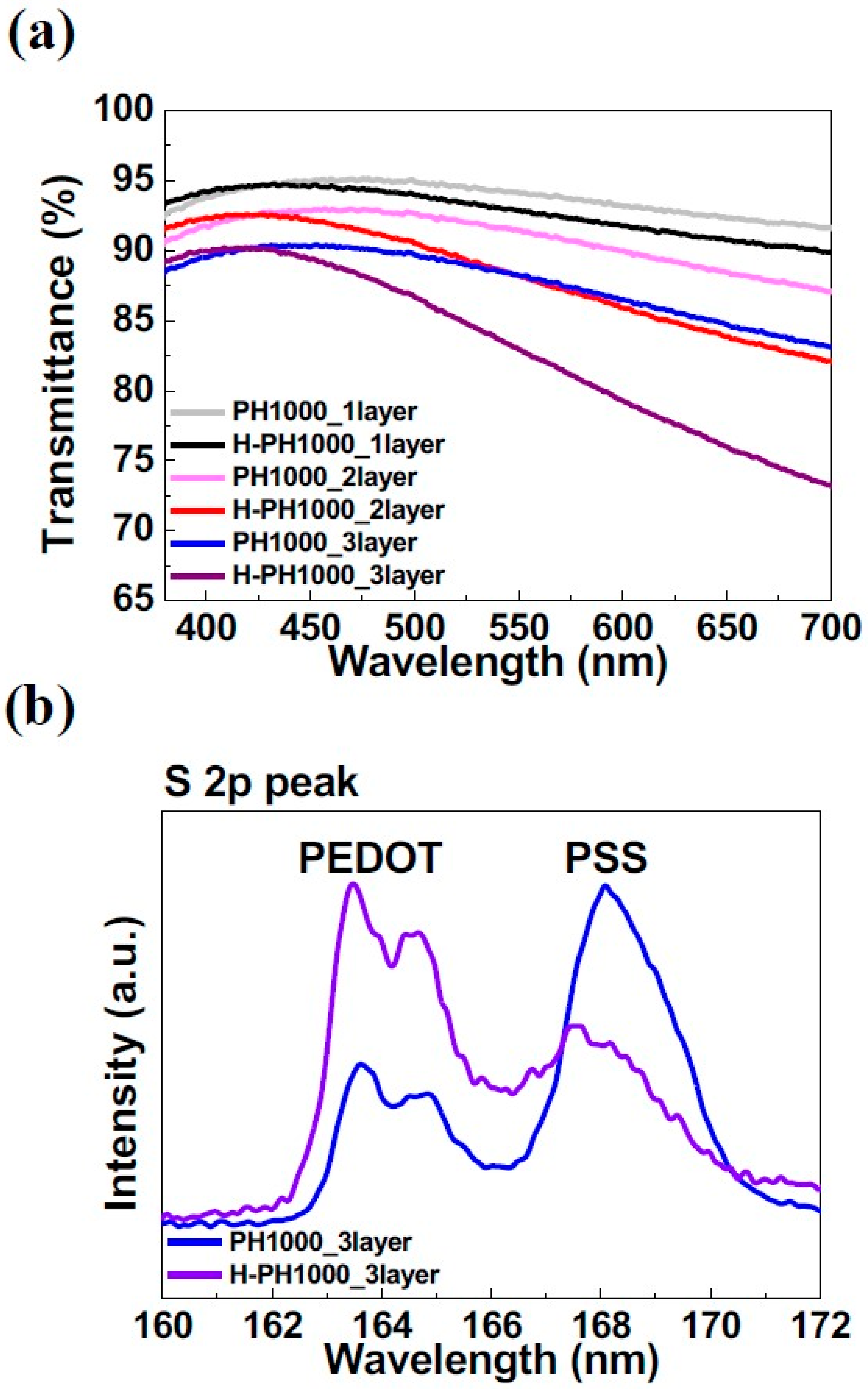
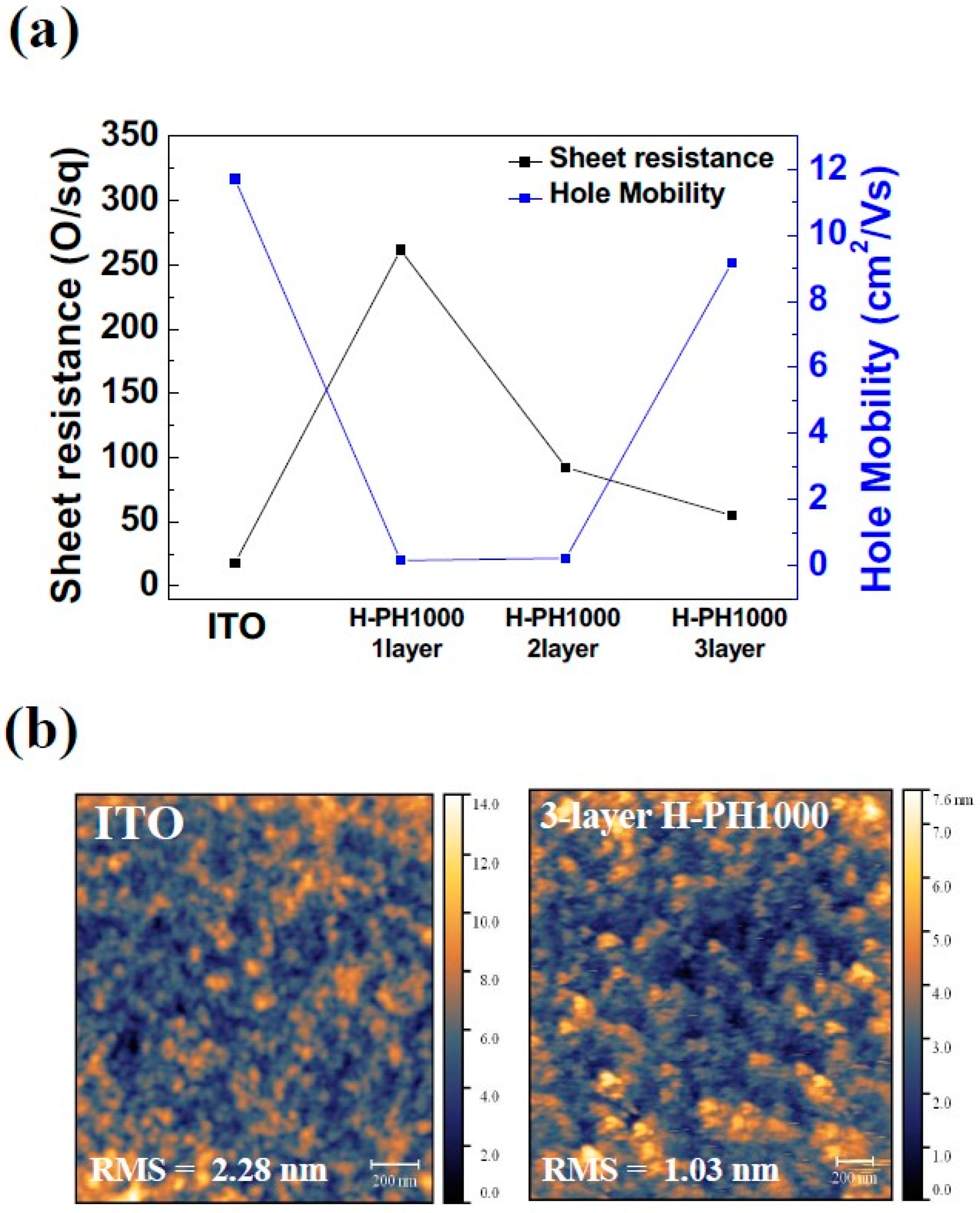
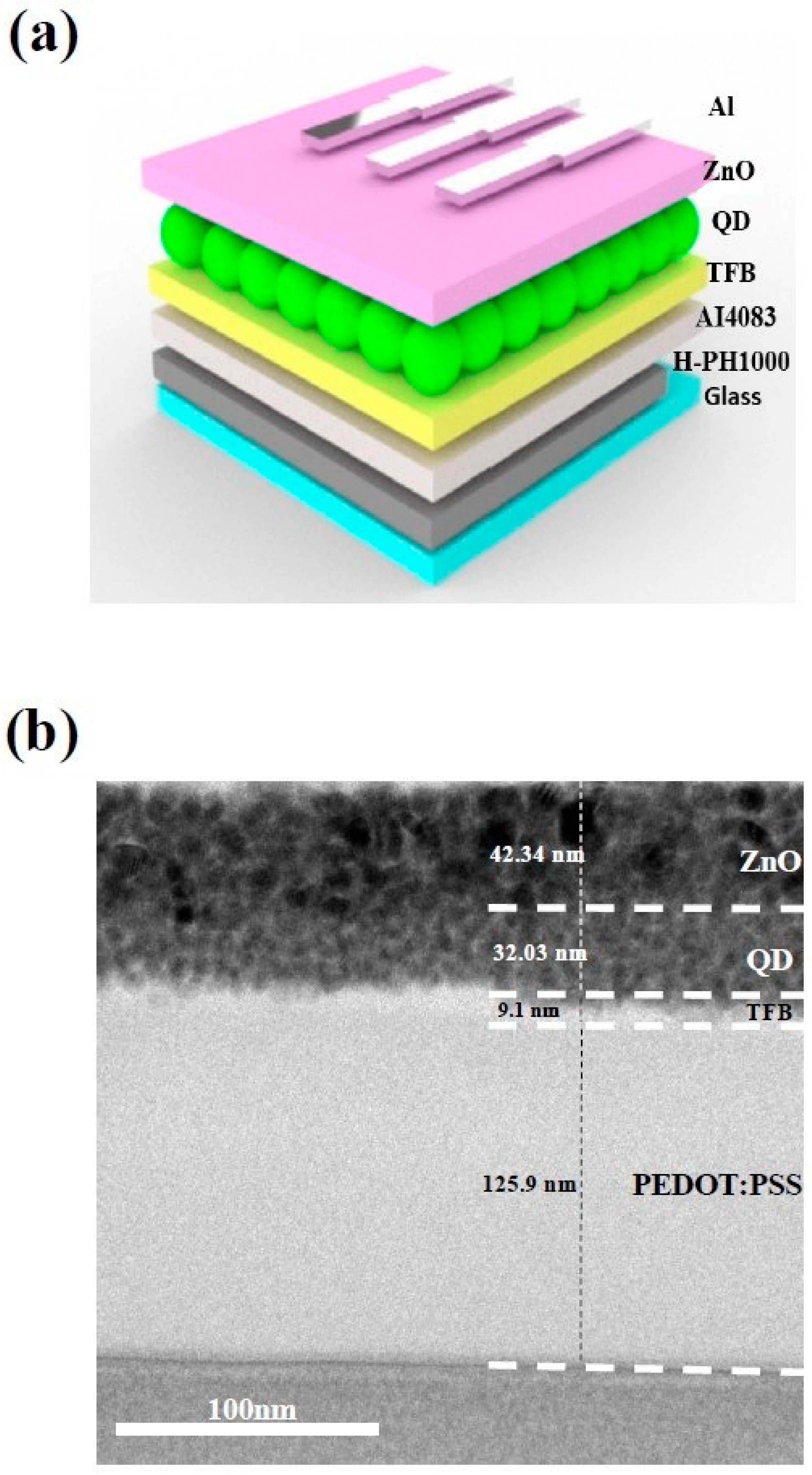
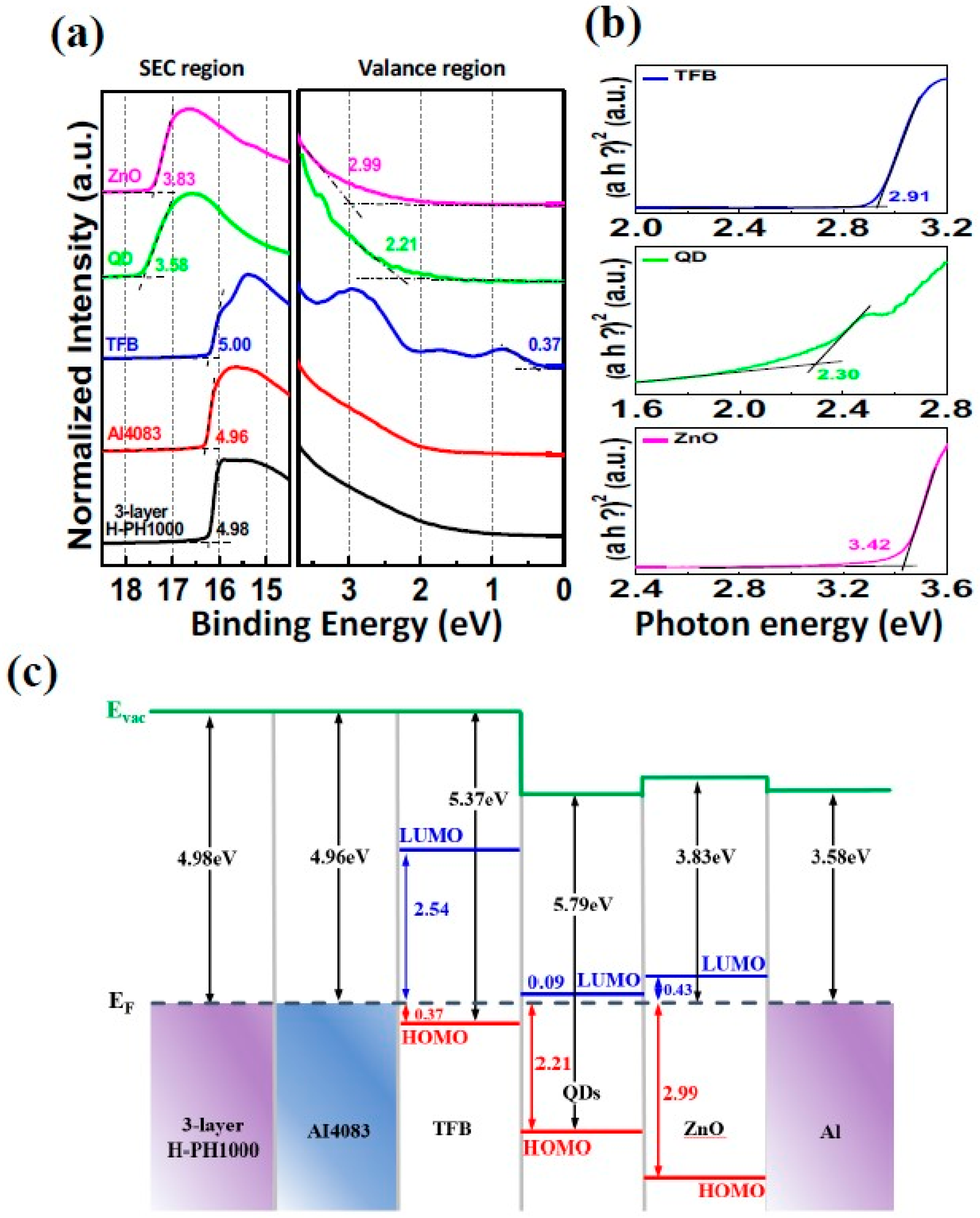
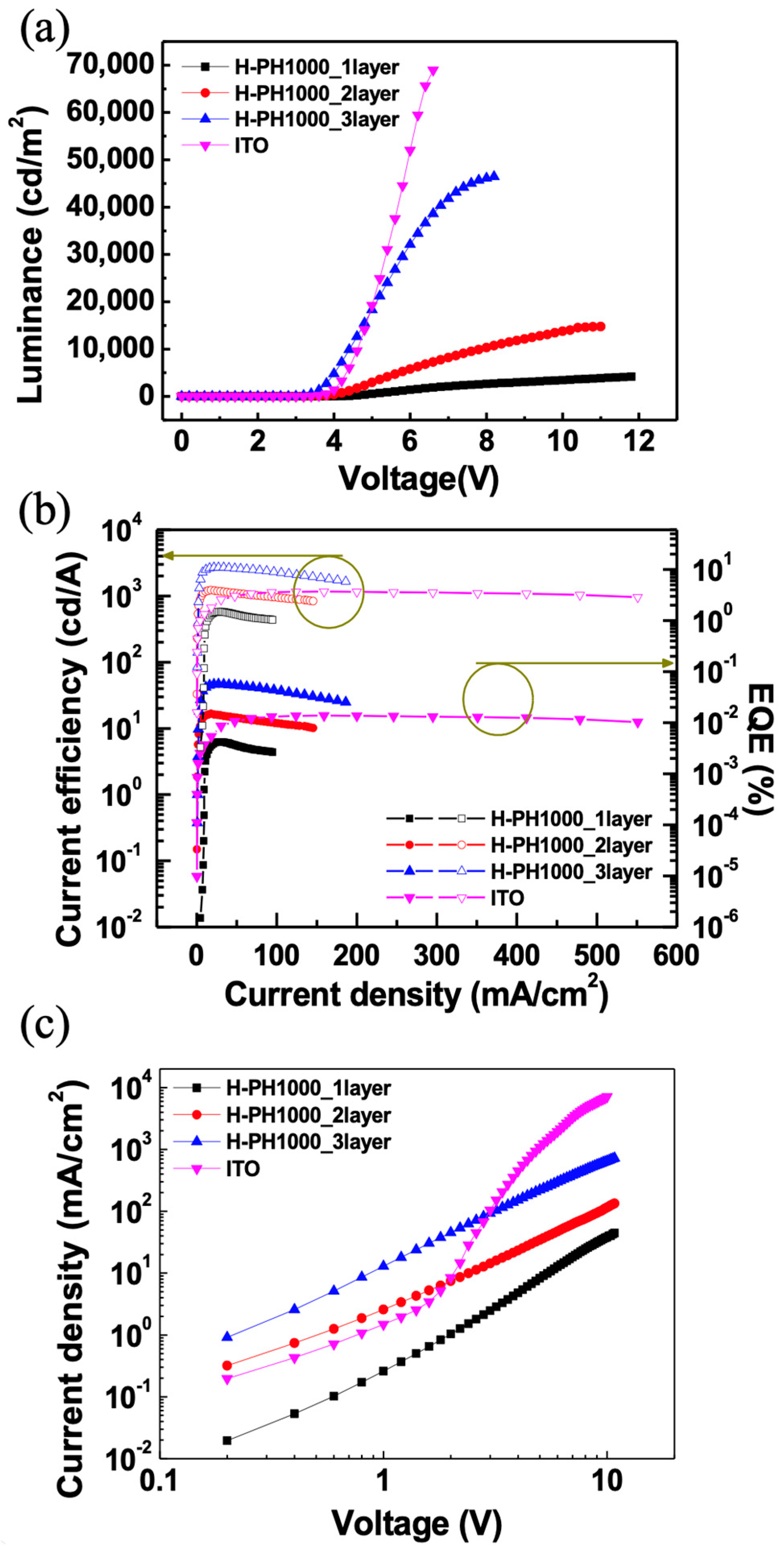

| Device | Max. L (cd/m2) | Turn on V (V) | Max. CE (cd/A) | Max. EQE (%) | CIE1931 (x,y) |
|---|---|---|---|---|---|
| H-PH1000_1layer | 4287 | 3.4 | 6.22 | 1.48 | (0.198, 0.758) |
| H-PH1000_2layer | 14,679 | 3.2 | 10.67 | 3.93 | (0.199, 0.759) |
| H-PH1000_3layer | 46,663 | 2.6 | 46.53 | 11.01 | (0.199, 0.758) |
| ITO | 68,977 | 3.0 | 15.62 | 3.69 | (0.204, 0.756) |
Disclaimer/Publisher’s Note: The statements, opinions and data contained in all publications are solely those of the individual author(s) and contributor(s) and not of MDPI and/or the editor(s). MDPI and/or the editor(s) disclaim responsibility for any injury to people or property resulting from any ideas, methods, instructions or products referred to in the content. |
© 2023 by the authors. Licensee MDPI, Basel, Switzerland. This article is an open access article distributed under the terms and conditions of the Creative Commons Attribution (CC BY) license (https://creativecommons.org/licenses/by/4.0/).
Share and Cite
Ma, J.H.; Kim, M.G.; Jeong, J.H.; Park, M.H.; Ha, H.J.; Kang, S.J.; Kang, S.J. Highly Efficient ITO-Free Quantum-Dot Light Emitting Diodes via Solution-Processed PEDOT:PSS Semitransparent Electrode. Materials 2023, 16, 4053. https://doi.org/10.3390/ma16114053
Ma JH, Kim MG, Jeong JH, Park MH, Ha HJ, Kang SJ, Kang SJ. Highly Efficient ITO-Free Quantum-Dot Light Emitting Diodes via Solution-Processed PEDOT:PSS Semitransparent Electrode. Materials. 2023; 16(11):4053. https://doi.org/10.3390/ma16114053
Chicago/Turabian StyleMa, Jin Hyun, Min Gye Kim, Jun Hyung Jeong, Min Ho Park, Hyoun Ji Ha, Seong Jae Kang, and Seong Jun Kang. 2023. "Highly Efficient ITO-Free Quantum-Dot Light Emitting Diodes via Solution-Processed PEDOT:PSS Semitransparent Electrode" Materials 16, no. 11: 4053. https://doi.org/10.3390/ma16114053





